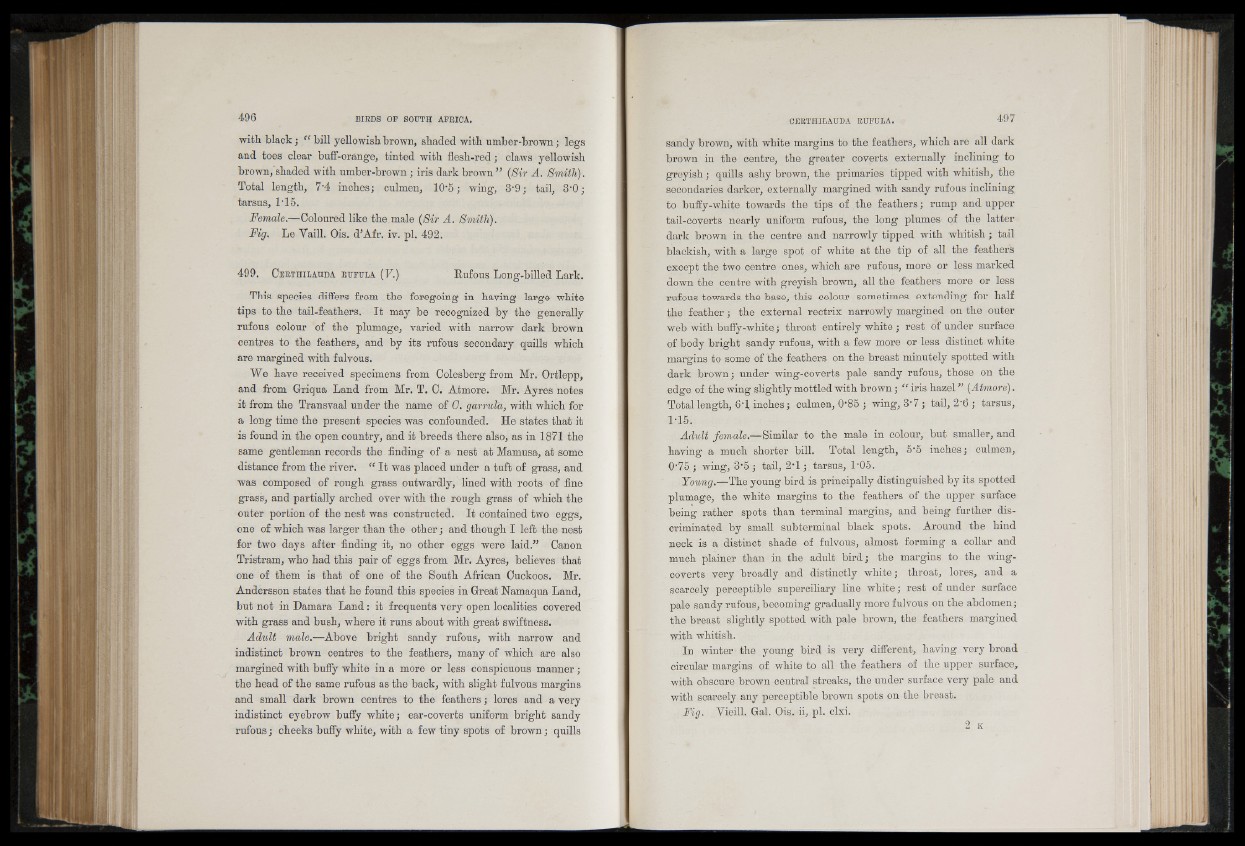
with black; ec bill yellowish brown, shaded with umber-brown; legs
and toes clear buff-orange, tinted with flesh-red; claws yellowish
brown, shaded with umber-brown; iris dark brown ” (Sir A. Smith).
Total length, 7"4 inches; culmen, 105; wing, 3-9; tail, 3-0 ;
tarsus, 1T5.
Female.—Coloured like the.male (Sir A. Smith).
Fig. Le Vaill. Ois. d’Afr. iv. pi. 492,
499. C er th ila u d a rufula (V.) Kufous Long-billed Lark.
This species differs from the foregoing in haying large white
tips to the tail-feathers. I t may be recognized by the generally
rufous colour of the plumage, varied with narrow dark brown
centres to the feathers, and by its rufous secondary quills which
are margined with fulvous.
We have received specimens from Colesberg from Mr. Ortlepp,
and from Griqua Land from Mr. T. C. Atmore. Mr. Ayres notes
it from the Transvaal under the name of 0. garrula, with which for
a long time the present species was confounded. He states that it
is found in the open country, and it breeds there also, as in 1871 the
same gentleman records the finding of a nest at Mamusa, at some
distance from the river. “ It was placed under a tuft of grass, and
was composed of rough grass outwardly, lined with roots of fine
grass, and partially arched over with the rough grass of which the
outer portion of the nest was constructed. It contained two eggs,
one of which was larger than the other; and though I left the nest
for two days after finding it, no other eggs were laid.” Canon
Tristram, who had this pair of eggs from Mr. Ayres, believes that
one of them is that of one of the South African Cuckoos. Mr.
Andersson states that he found this species in Great Namaqua Land,
but not in Damara Land: it frequents very open localities covered
with grass and bush, where it runs about with great swiftness.
Adult male.—Above bright sandy rufous, with narrow and
indistinct brown centres to the feathers, many of which are also
margined with buffy white in a more or less conspicuous manner;
the head of the same rufous as the back, with slight fulvous margins
and small dark brown centres to the feathers; lores and a very
indistinct eyebrow buffy white; ear-coverts uniform bright sandy
rufous; cheeks buffy white, with a few tiny spots of brown; quills
sandy brown, with white margins to the feathers, which are all dark
brown in the centre, the greater coverts externally inclining to
greyish; quills ashy brown, the primaries tipped with whitish, the
secondaries darker, externally margined with sandy rufous inclining
to buffy-white towards the tips of the feathers; rump and upper
tail-coverts nearly uniform rufous, the long plumes of the latter
dark brown in the centre and narrowly tipped with whitish; tail
blackish, with a large spot of white at the tip of all the feathers
except the two centre ones, which are rufous, more or less marked
down the centre with greyish brown, all the feathers more or less
rufous towards the base, this colour sometimes extending for half
the feather; the external rectrix narrowly margined on the outer
web with buffy-white; throat entirely white; rest of under surface
of body bright sandy rufous, with a few more or less distinct white
margins to some of the feathers on the breast minutely spotted with
dark brown; under wing-coverts pale sandy rufous, those on the
edge of the wing slightly mottled with brown; “ iris hazel ” (Atmore).
Total length, 6'1 inches; culmen, 0'85 ; wing, 3'7 ; tail, 2'6 ; tarsus,
1-15.
Adult female.—Similar to the male in colour, but smaller, and
having a much shorter bill. Total length, 5'5 inches; culmen,
0'75; wing, 3'5 ; tail, 2'1; tarsus, 1'05.
Young.—The young bird is principally distinguished by its spotted
plumage, the white margins to the feathers of the upper surface
being rather spots than terminal margins, and being further discriminated
by small subterminal black spots. Around the hind
neck is a distinct shade of fulvous, almost forming a collar and
much plainer than in the adult bird; the margins to the wing-
coverts very broadly and distinctly white; throat, lores, and a
scarcely perceptible superciliary line white; rest of under surface
pale sandy rufous, becoming gradually more fulvous on the abdomen;
the breast slightly spotted with pale brown, the feathers margined
with whitish.
In winter the young bird is very different, having very broad
circular margins of white to all the feathers of the upper surface,
with obscure brown central streaks, the under surface very pale and
with scarcely any perceptible brown spots on the breast.
Fig. Vieill. Gal. Ois. ii, pi. clxi.